The Warsaw Redevelopment Commission approved an updated contaminated aquifer comfort letter and project status letter for the Gatzke site at the Monday afternoon meeting.
City planner Jeremy Skinner said about a year ago, the Indiana Department of Environment Management approached him about updating the Gatke environmental studies to include cell organic compounds IDEM is starting to look for.
The 3.30-acre site is compromised of two parcels. The site is surrounded to the north by McKinley Street and a truck repair facility; to the east by McKinley Street and former Warsaw Chemical; and to the south and west by an active railroad, Winona Avenue and Winona Lake.
“The site was initially developed as the power plant for the Winona Lake Interurban Railroad and the town of Winona Lake in 1906. The power plant was purchased by the Gatke Corporation in 1926 and was redeveloped for use as an asbestos friction and bearing products manufacturer until 1976. After 1976, Gatke continued to manufacture similar products without asbestos until 1993. The site has been vacant since Gatke ceased its operations in 1993.
“The site was acquired by the Warsaw Redevelopment Commission in September 2003. The Warsaw Redevelopment Commission plans to redevelop a portion of the site as a retail space to be rented to local artisans and use the remainder of the site for associated parking and greenspace,” according to the project status letter.
The new comfort letter will replace the original comfort letter the committee signed in 2000. Skinner said not a lot has changed. However, there are some new vapor barrier requirements. The use of the original comfort letter has come and gone. It was a basic comfort letter and didn’t “any residental use, allow utilization of groundwater,” Skinner said.
A comfort letter explains the liability exemption or enforcement discretion policy for which the stakeholder has qualified and by which IDEM has determined not to pursue a party for cleanup.
Skinner said the letter covers the entire property and all the buildings in the area. The water vapor barrier would have to be installed if someone would come in to develop the property.
The comfort letter is trying to allow the committee to develop the property, he said. “They’re doing it with environmental restrictions and making them publicly known. That’s what the comfort letter is.
“It also tells the city about those environmental liabilities because they were before we acquired the property,” Skinner said. The most recent comfort letter details contaminants “coming from down the hill, if you will, from the adjacent company that are impacting the readings they had in 2018 and 2019,” Skinner said. It updates the expectations of who can use the property and how.
The letter does give developers an “out” where if they can do a study and if the results comes back with any results that state any issues are not subsurface. Any asbestos was dealt with through grants, Skinner said.
In other news, the commissioners:
• Approved $5,500 to be moved from the improvement/other building fund to the debt service fund.





